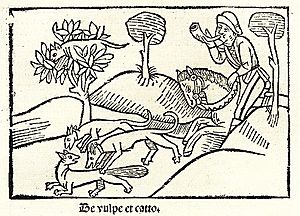The Fox and the Cat (fable) facts for kids
The Fox and the Cat is a very old story, also known as a fable. It has been told in many parts of the world, using different animals. This fable helps us think about two different ways of solving problems: having one really good plan or having many smaller tricks.
This story is part of famous collections like Aesop's fables. It is listed as number 605 in a special list called the Perry Index. The basic story goes like this: A cat and a fox are talking about how many clever tricks they know. The fox brags that he knows many ways to escape trouble. The cat, however, says she only knows one trick.
Suddenly, hunters arrive with their dogs. The cat quickly uses her one trick and climbs a tall tree. The fox, on the other hand, thinks of many different ways to escape. But he takes too long to choose a plan. Because he can't decide, the dogs catch him. People have learned many lessons from this fable over time. Even today, people like the writer Isaiah Berlin still find new meanings in it.
Contents
Understanding the Fable's Meaning
This fable teaches us about different ways to deal with problems. It compares having one strong, quick solution to having many ideas but not acting fast enough.
The Hedgehog and the Fox Idea
Another old fable, similar to this one, talks about a hedgehog and a fox. In that story, the difference is between running away and defending yourself. The cat and fox story is more about different ways to escape.
A long time ago, during the Renaissance, a writer named Laurentius Abstemius wondered if the cat's simple, quick solution was better than the fox's many clever ideas. He rewrote the fable with a hare and a fox. The hare boasted about how fast it was. But the fox pointed out that being sly and smart was a better way to survive. Abstemius concluded that being intelligent is the best quality.
People still think about these ideas today. The philosopher Isaiah Berlin wrote an important essay in 1953 called "The Hedgehog and the Fox". He used the idea from an ancient saying to divide thinkers into two groups:
- Hedgehogs: These thinkers see the world through one main, big idea. Everything fits into that one idea.
- Foxes: These thinkers have many different experiences and ideas. They believe the world is too complex for just one simple idea.
Berlin's essay has been very important. Many writers have used his idea to describe different ways of thinking.
How Ideas Connect: Science and Humanities
The writer Stephen Jay Gould used Berlin's ideas and the fable in his book, The Hedgehog, the Fox, and the Magister's Pox. He explored how science and the humanities (like history and art) are connected. Gould saw two main lessons in the old fable for people:
- How we act: Do we quickly try many things, or do we stick with one plan?
- How we think: Do we learn many different things, or do we focus deeply on one area?
Gould believed that combining both ways of thinking is the best way to truly understand things.
Art and New Interpretations
The artist Richard Serra also named one of his sculptures "The Hedgehog and the Fox" (1999). This sculpture is at Princeton University. Serra explained that his sculpture shows how students can either become free thinkers and create new things, or they can just follow old rules.
Serra's view is a bit different from the original fable. He saw the hedgehog, which resists change, as being stuck. The fox, which can adapt and change, showed the right way for minds to grow and survive.
|


